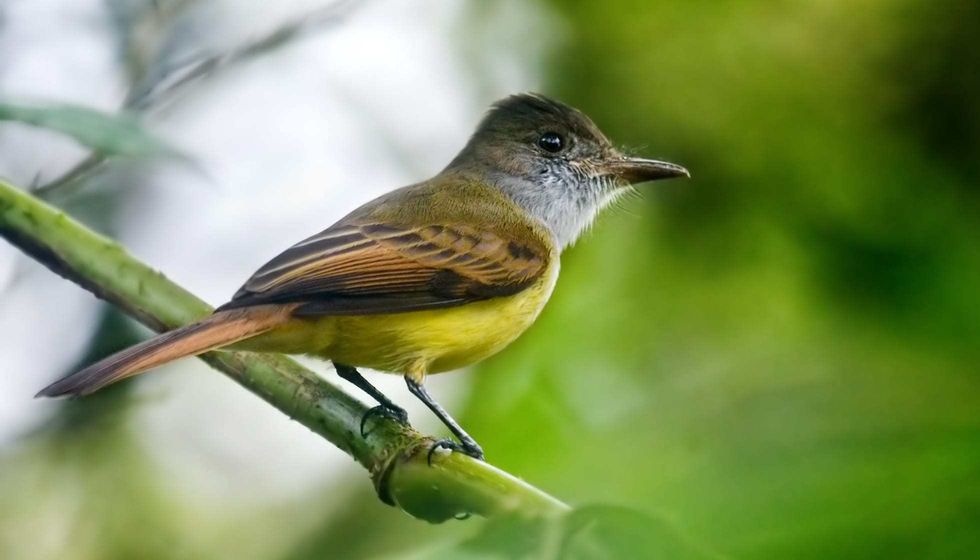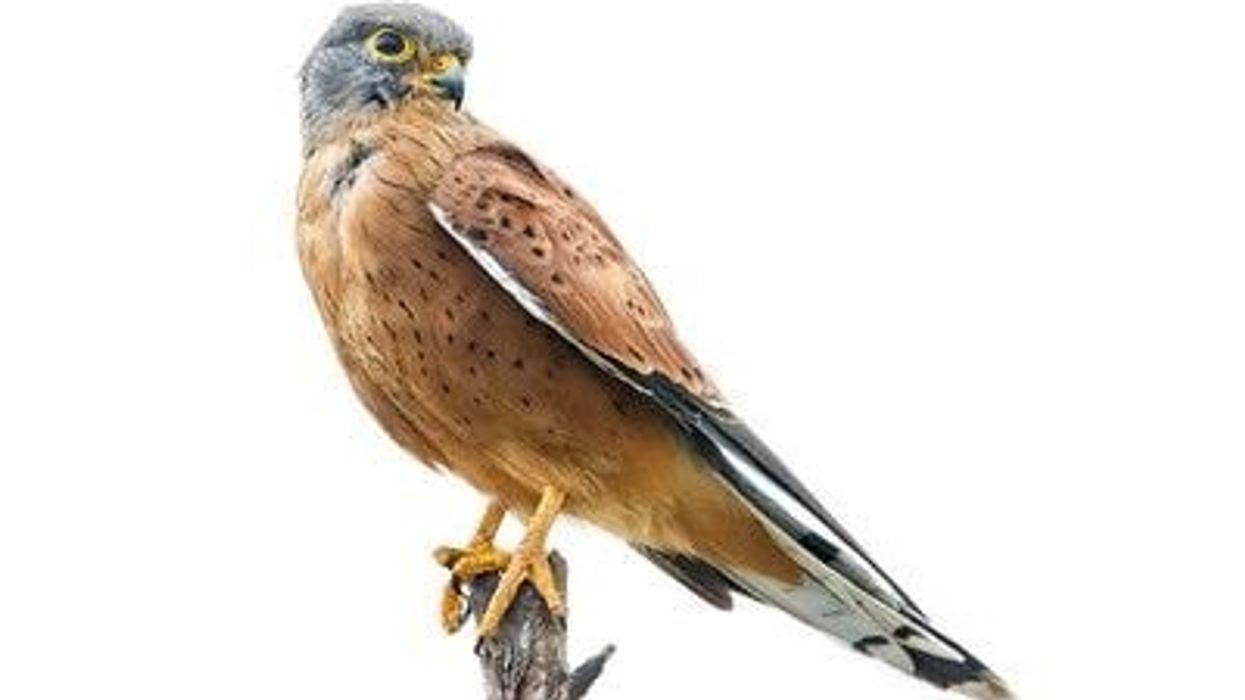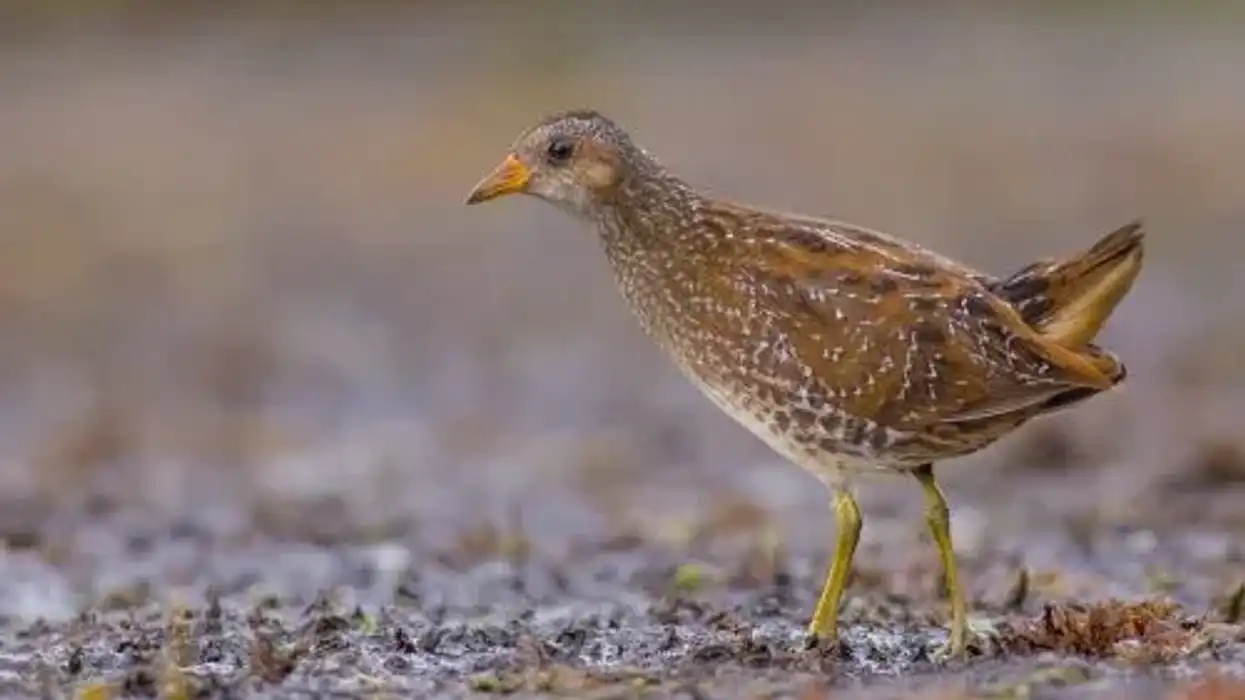The great crested flycatchers are also known by their scientific name Myiarchus crinitus, which is a large bird that feeds primarily on insects and resides in open woodland areas and trees in places like north, central, and southern parts of South America. They breed across parts of the United States as well as Canada.
The great crested flycatcher call is a loud 'wee-eep' call enough to recognize its presence in breeding and wintering grounds.
Its dawn song is short and distinctive that last quarter of a second. Great crested flycatcher song repeats at 60 chebecs per minute.
These birds are endothermic, homeothermic, and have bilateral symmetry. They are territorial birds and specifically during breeding season male birds defend their breeding territories while females construct the nest.
They make use of visual, acoustic, and tactile means to communicate through the use of calls and sounds. They are responsible for controlling insect populations and sustaining a balance in the ecosystem. In this article, we will take a look at some interesting information and facts about these unique and beautiful birds.
Great Crested Flycatcher Interesting Facts
What type of animal is a great crested flycatcher?
The great crested flycatcher (Myiarchus crinitus) is a type of birds animal and belongs to the kingdom animalia.
What class of animal does a great crested flycatcher belong to?
The great crested flycatcher (Myiarchus crinitus) belong to the class aves and is a type of bird that feeds on insects and resides mostly on treetops itself.
How many great crested flycatchers are there in the world?
The exact number of these north American birds is undetermined however they are identified as a bird in the least concern category.
Where does a great crested flycatcher live?
The great crested flycatchers live in deciduous forests in the woods and also reside in areas away from the ground like near a house where there are nest boxes, pipes, or cans.
What is a great crested flycatcher's habitat?
Great crested flycatchers reside in forests and prefer residing on deciduous trees and woodlands primarily due to their dietary requirements of feeding on insects. This species of birds are found in semi-open canopy regions or in the forest edges.
Popular known places where these birds of north America originate and exist today include parts of South America, the united states, and parts of Canada.
Who do great crested flycatchers live with?
Since they reside in forest regions, they are surrounded by their own species as well as other insects, birds, and animals in the forests some of whom they prey on and some of whom these birds are prey to. Eggs, as well as the crested flycatcher birds, serve as prey for predators in the forests like snakes.
Other animals who they compete with to survive in the wild include squirrels, woodpeckers, and other nesting species.
How long does a great crested flycatcher live?
The expected lifespan of the birds native to the open woodland is from two to ten years of age. The oldest living great crested flycatcher bird lived 14 years and 11 months as per records and this was found in Vermont in the year 1967.
How do they reproduce?
This bird lays four to six eggs in a single clutch in a nest that the parent birds build before giving birth in the months of mid April to late June post this breeding season begins. During courtship rituals, they tend to become aggressive.
The eggs (0.6-0.7 inches) are then incubated for two weeks by the female and fed food as well.
The eggs appear creamy-white with a pinkish buff splotch with brown, purple, and lavender. Post-hatching from the egg the nestlings spend another two weeks residing in the nest before they are expected to begin to fledge and ultimately begin to fly using their feathers.
What is their conservation status?
The species is considered the Least Concern species by the International Union For Conservation Of Nature (IUCN). Although they are the least concerned species they too have been severely affected by pesticide use and man-made structures.
Great Crested Flycatcher Fun Facts
What do great crested flycatchers look like?
The great crested flycatchers look like extremely beautiful birds who are reddish-brown, plus a brownish-gray head, a bright yellow belly, and gray throat and breast. The brown upper parts of the bird's body are highlighted so are its tail feathers with rufous orange flashes.
How cute are they?
This North American bird is extremely beautiful and cute in appearance with its unique features. They usually reside in great heights above the ground. When this bird gets excited they show a soft fluffy crest.
How do they communicate?
Birds usually chirp and this bird too makes use of sounds to communicate. The female and male birds have a loud 'wee-eep' call enough to recognize its presence in breeding and wintering grounds.
The male bird's voice sounds like a dry chebec while the female bird's voice sounds like a call. Its dawn song is short and distinctive that last quarter of a second. Great crested flycatcher song repeats sometimes at 60 checbecs per minute.
How big is a great crested flycatcher?
The great crested flycatcher is 6.7-8.3 inch tall which is 17-21 cm five times bigger compared to the smallest bird in the world the bee hummingbird which is 2.4 inch (6.1cm) tall.
How fast can a great crested flycatcher fly?
They fly at fast speeds to ensure they catch their prey, such as insects. This may include both flying insects as well as ones that don't fly. This bird spends little time on the ground and does not enjoy walking or hopping. Flying is what this bird enjoys best.
How much does a great crested flycatcher weigh?
This bird weighs somewhere between 27-40 g which is about 0.074 lb. Since they are active and agile birds they remain fit throughout their life. The male is slightly larger in plumage as compared to females.
What are their male and female names of the species?
The male and female do not have any separate names however there are a number of ways to find the differences between the two. The male is slightly larger in plumage as compared to females and the male bird's voice sounds like a dry chebecs while the female bird's voice sounds like a call.
What would you call a baby great crested flycatcher?
The eggs and young species of the great crested flycatcher are extremely small in size. The eggs are referred to the same until they hatch and then are referred to as nestlings until they grow up develop feathers and wings and are ready to fly as an adult bird.
What do they eat?
They primarily feed on instincts and feed on a wide range of insects like caterpillars, moths, butterflies, beetles, bugs, tree crickets, small lizards, wasps as well as fruits and berries and seeds.
Are they dangerous?
The crested flycatcher is not at all a dangerous bird. When attacked by predators like snakes its immediate instinct is to flee from the area.
Would they make a good pet?
The birds ideally reside in deciduous regions and out in the wild. Keeping them as pets would be restrictive for these birds who love to fly so keeping them as pets is not a good idea considering they are wild birds. One can visit them in facilities where they are enjoyed by birdwatchers.
Did you know...
An interesting fact about these birds is that they mate for life. The great crested flycatchers are monogamous. The nests made by the great crested flycatcher birds may contain a shed snakeskin or other similar materials like plastic and cellophane. Many parasites are found in nesting cavities where these birds live.
The eastern phoebes are similar-looking birds with white underparts but smaller species as compared to the great crested birds. Other similar species include the brown crested flycatcher, ash throated flycatcher, and the eastern wood pewee.
In Tennessee, they are a common resident species in the summer and arrive by mid of April and depart by mid-September.
The great crested flycatcher's call
The bird communicates primarily via calls and sounds. Calls occur when in a position of threat wherein they become louder until they reach a safe place.
The sounds on the other hand are distinctive in nature as compared to other birds and the song consists of two notes that last less than a quarter of a second. They repeat the sound every now and then. Both males and female birds whit softly while feeding nestlings in the nest.
Where do great crested flycatchers nest?
Great crested flycatcher nest in cavities in dead trees as well as large woodpecker holes, nesting boxes, pipes, cans in a range of 2-70 feet off the ground. This bird is rarely found on the ground as it resides mostly in treetops in their nest boxes.
One can attract a myiarchus crinitus by installing a nesting space for them since in many instanced these birds find it difficult to find a nest. Installing a nest box can attract breeding pairs.
These unique species are truly beautiful and magnificent birds. They provide no economic benefits but are an essential part of the ecosystem and are an excellent view for birdwatchers around the world.
Here at Kidadl, we have carefully created lots of interesting family-friendly animal facts for everyone to discover! You can even occupy yourself at home by drawing one on our Great crested flycatcher coloring pages.










